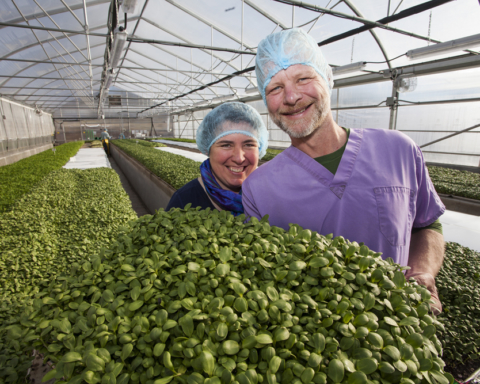Learning From Italy’s Thriving Agriculture Co-operatives
By Chris Bodnar
Over two weeks in June, I had the opportunity to join other farmers and a group of Vancity Credit Union staff on a study tour in Bologna, Italy. The focus of the tour was the agricultural co-operative sector.
The Bologna region is unique because of its co-operative sector. It is located in the heart of the Emilia-Romagna region, which is an agricultural center of Italy. Agriculture in this region makes up 4% of the region’s employment, while the overall agrifood system (including agriculture, food science, distribution, retail, and restaurants) makes up 16.7% of the region’s employment.
Co-operatives are integral to the region’s overall economy of the region. While only 1.3% of businesses in the region are co-operatives, they generate approximately 15% of the region’s employment and 20% of the region’s GDP. Co-ops play an even larger role in agriculture and agrifood systems. 95% of the region’s wine is produced by co-operatives. Co-operatives pack and distribute much of the fresh produce, meat, and dairy. Over 60% of the region’s groceries are purchased through consumer co-operatives.
In many ways, Italian farmers are facing the same challenges as farmers in BC and other parts of the world. The production of agricultural land is decreasing, the age of farmers is increasing, and many rural areas are depopulating. Global trade has made it more difficult for individual operators to access markets.
By working together in co-operatives, the farmers of Emilia-Romagna have been able to respond to the global pressures on agriculture. Co-operatives have allowed farms to specialize, produce high-quality, value added products, and sell into an international market.
The specialty products of Emilia-Romagna farmers are known around the world. For example, farmers don’t just produce milk; they make Parmesan Cheese. Farmers don’t just grow grapes; they make high-end wines and balsamic vinegar.
Now, agricultural universities in the Emilia-Romagna region are at enrolment capacity and many see new opportunities to maintain the region’s agricultural strength into the future.

BC Farmer Arzeena Hamir speaks with a Fattoria Rio Selva farmer who specializes in radicchio production using permaculture practices in the Treviso region of Italy. Photo Credit: Chris Bodnar
Some of the key lessons from the study tour are:
Supporting Diversity of Scale
The processing co-operatives we visited had many farmer members—up to 1,400 in some cases. These members were not uniform in size. Some farm a couple of hectares while others farm 25 to 30 hectares. The co-operatives are open to members of all sizes. This supports a diversity of farmers to continue producing when many would otherwise be unable to access markets on their own. In turn, most co-ops have rules that require members to sell exclusively to the co-op.
Market Response
A key message we heard throughout our trip was that Italian consumers increasingly demand environmentally responsible production of their food products. Co-operatives have helped farmers adapt to these demands through extension services, restricting the use of GMOs, and marketing products in response to consumer demands. In some instances, co-ops have focused on Integrated Pest Management (IPM) practices to reduce chemical use. In others, they have helped coordinate transition to organic certification by ensuring market access for products. Overall, 8% of Emilia-Romagna’s agricultural land is farmed organically.
It’s All About Quality
Italian co-operatives place a high importance on overall quality. Many producer co-operatives provide extension support to their growers to help growers achieve the highest quality possible. By requiring members to sell exclusively to the co-op, the co-op is also assured it will receive the highest quality product and that growers will not undercut the co-op in the marketplace.
The co-operatives also invest in infrastructure to ensure their processing, packing, and value-added products meet the highest standards. For example, one wine producer we visited has a full-time lab that tests grape samples and wine batches daily, a task individual producers could not achieve on their own.
The el Tamiso organic co-operative manager explains that their co-operative of 35 members has grown by 10% annually and now distributes across Europe. Photo Credit: Chris Bodnar.
It’s Also About Logistics
An efficient food system ultimately comes down to being able to move the food products to market in a fast and efficient manner. We visited two distribution centers where many distributors are housed in one facility. By co-locating, distributors have been able to achieve logistical systems that support getting their product to market. Buyers are able to visit one facility and purchase from over 35 distributors, representing hundreds of farms. The Bologna distribution facility can load 30 trucks an hour, sending produce across Europe each day. One organic co-operative of 35 farms, el Tamiso, has been able to grow sales at a rate of over 10% annually by being able to access improved logistical services through these shared facilities.
Building Resilience During Plentiful Times
A key lesson from the Italian co-operative model is that co-operatives are incentivized to save during good times in order to be better prepared for the bad times. Profits are not taxed if they are kept within the co-operative as “indivisible reserves.” These reserves cannot be paid out to members, but can be used to stabilize the co-op during poor economic conditions. This helps to achieve balance in the co-ops’ annual finances; they attempt to achieve the best possible return to the farmers for their products while building reserves to support the long-term well being of the co-op.
The results of this planning are clear: during the economic crisis of the past decade, the number of businesses in the region decreased by 1.9%, while the number of co-operatives actually increased by 5%. During the same period, employment decreased by 3.8% while employment in co-operatives went up by 3%.
Using Scale to Access Opportunities
Ultimately, Italian agricultural co-operatives have allowed farmers to achieve a critical scale to produce high-quality products that sell into global markets. While these co-operatives started small, many have merged over the past two decades in order to be better positioned for global trade. The primary lesson learned in this example is that co-operatives can scale up and take advantage of new opportunities while respecting and supporting a diversity of scales of farming.
Chris Bodnar co-owns and operates Close to Home Organics with his wife, Paige, at Glen Valley Organic Farm in Abbotsford. They operate a 145-member Community Shared Agriculture program and sell at two weekly farmers markets during the farming season. Prior to farming, Chris earned a PhD in Communication from Carleton University. He now teaches the Business of Agriculture course in Kwantlen Polytechnic University’s Sustainable Agriculture program. Chris sits on the board of the Mount Lehman Credit Union.
Feature image: The Cantina di Sorbara produces Lambrusco wine for Italian and international markets. The co-operative of 1200 members has invested in five processing plants and lab facilities to test grape and wine samples daily to ensure it is producing the highest-quality product possible. Photo Credit: Chris Bodnar











